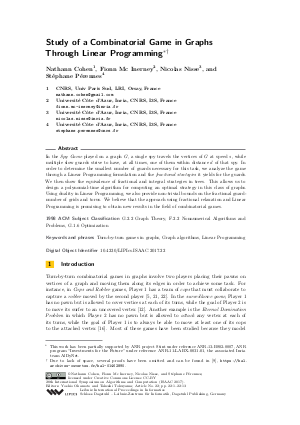Study of a Combinatorial Game in Graphs Through Linear Programming
Authors Nathann Cohen, Fionn Mc Inerney, Nicolas Nisse, Stéphane Pérennes
-
Part of:
Volume:
28th International Symposium on Algorithms and Computation (ISAAC 2017)
Part of: Series: Leibniz International Proceedings in Informatics (LIPIcs)
Part of: Conference: International Symposium on Algorithms and Computation (ISAAC) - License:
 Creative Commons Attribution 3.0 Unported license
Creative Commons Attribution 3.0 Unported license
- Publication Date: 2017-12-07
File

PDF
LIPIcs.ISAAC.2017.22.pdf
- Filesize: 0.73 MB
- 13 pages
Document Identifiers
Subject Classification
Keywords
- Turn-by-turn games in graphs
- Graph algorithms
- Linear Programming
Metrics
- Access Statistics
-
Total Accesses (updated on a weekly basis)
0Document
0Metadata
Abstract
In the Spy Game played on a graph G, a single spy travels the ertices of G at speed s, while multiple slow guards strive to have, at all times, one of them within distance d of that spy. In order to determine the smallest number of guards necessary for this task, we analyze the game through a Linear Programming formulation and the fractional strategies it yields for the guards. We then show the equivalence of fractional and integral strategies in trees. This allows us to design a polynomial-time algorithm for computing an optimal strategy in this class of graphs. Using duality in Linear Programming, we also provide non-trivial bounds on the fractional guardnumber of grids and torus. We believe that the approach using fractional relaxation and Linear Programming is promising to obtain new results in the field of combinatorial games.
Cite As Get BibTex
Nathann Cohen, Fionn Mc Inerney, Nicolas Nisse, and Stéphane Pérennes. Study of a Combinatorial Game in Graphs Through Linear Programming. In 28th International Symposium on Algorithms and Computation (ISAAC 2017). Leibniz International Proceedings in Informatics (LIPIcs), Volume 92, pp. 22:1-22:13, Schloss Dagstuhl – Leibniz-Zentrum für Informatik (2017)
https://doi.org/10.4230/LIPIcs.ISAAC.2017.22
BibTex
@InProceedings{cohen_et_al:LIPIcs.ISAAC.2017.22,
author = {Cohen, Nathann and Mc Inerney, Fionn and Nisse, Nicolas and P\'{e}rennes, St\'{e}phane},
title = {{Study of a Combinatorial Game in Graphs Through Linear Programming}},
booktitle = {28th International Symposium on Algorithms and Computation (ISAAC 2017)},
pages = {22:1--22:13},
series = {Leibniz International Proceedings in Informatics (LIPIcs)},
ISBN = {978-3-95977-054-5},
ISSN = {1868-8969},
year = {2017},
volume = {92},
editor = {Okamoto, Yoshio and Tokuyama, Takeshi},
publisher = {Schloss Dagstuhl -- Leibniz-Zentrum f{\"u}r Informatik},
address = {Dagstuhl, Germany},
URL = {https://drops.dagstuhl.de/entities/document/10.4230/LIPIcs.ISAAC.2017.22},
URN = {urn:nbn:de:0030-drops-82254},
doi = {10.4230/LIPIcs.ISAAC.2017.22},
annote = {Keywords: Turn-by-turn games in graphs, Graph algorithms, Linear Programming}
}
Author Details
References
-
M. Aigner and M. Fromme. A game of cops and robbers. Discrete Applied Mathematics, 8:1-12, 1984.

- P. Balister, S. Binski, B. Bollobás, and B. P. Narayanan. Catching a fast robber on the grid. CoRR, abs/1609.01002, 2016. URL: http://arxiv.org/abs/1609.01002.
-
I. Beaton, S. Finbow, and J.A. MacDonald. Eternal domination numbers of 4× n grid graphs. J. Comb. Math. Comb. Comput., 85:33-48, 2013.

-
A. Bonato, E. Chiniforooshan, and P. Pralat. Cops and robbers from a distance. Theor. Comput. Sci., 411(43):3834-3844, 2010.

-
A. Bonato and R. J. Nowakowski. The game of Cops and Robbers on Graphs. American Math. Soc., 2011.

-
J. A. Bondy and U. S. R. Murty. Graph theory, volume 244 of Graduate Texts in Mathematics. Springer, 2008.

-
A. Burger, E. J. Cockayne, W. R. Gründlingh, C. M. Mynhardt, J. H. van Vuuren, and W. Winterbach. Infinite order domination in graphs. J. Comb. Math. Comb. Comput., 50:179-194, 2004.

-
N. Cohen, M. Hilaire, N. A. Martins, N. Nisse, and S. Pérennes. Spy-game on graphs. In 8th International Conference on Fun with Algorithms, FUN 2016, pages 10:1-10:16, 2016.

- N. Cohen, F. Mc Inerney, N. Nisse, and S. Pérennes. Study of a combinatorial game in graphs through linear programming. Technical report, INRIA, 2017. URL: https://hal.archives-ouvertes.fr/hal-01462890.
- N. Cohen, N. A. Martins, F. Mc Inerney, N. Nisse, S. Pérennes, and R. Sampaio. Spy-game on graphs: complexity and simple topologies. Technical report, INRIA, 2017. URL: https://hal.archives-ouvertes.fr/hal-01463297.
-
A. Z. Delaney and M. E. Messinger. Closing the gap: Eternal domination on 3× n grids. to appear in Contributions to Discrete Mathematics, 2015.

-
F. V. Fomin, F. Giroire, A. Jean-Marie, D. Mazauric, and N. Nisse. To satisfy impatient web surfers is hard. In 6th Int. Conf. on Fun with Algorithms (FUN), volume 7288 of LNCS, pages 166-176, 2012.

-
F. V. Fomin, P. A. Golovach, J. Kratochvíl, N. Nisse, and K. Suchan. Pursuing a fast robber on a graph. Theor. Comput. Sci., 411(7-9):1167-1181, 2010.

-
F. Giroire, D. Mazauric, N. Nisse, S. Pérennes, and R. P. Soares. Connected surveillance game. In 20th International Colloquium on Structural Information and Communication Complexity (SIROCCO), Lecture Notes in Computer Science. Springer, 2013.

- F. Giroire, N. Nisse, S. Pérennes, and R. P. Soares. Fractional combinatorial games. Technical report, INRIA, 2013. RR8371. URL: http://hal.inria.fr/hal-00865345.
-
W. Goddard, S. M. Hedetniemi, and S. T. Hedetniemi. Eternal security in graphs. J. Comb. Math. Comb. Comput., 52:160-180, 2005.

-
D. Gonçalves, A. Pinlou, M. Rao, and S. Thomassé. The domination number of grids. SIAM J. Discrete Math., 25(3):1443-1453, 2011.

-
W. B. Kinnersley. Cops and robbers is exptime-complete. JCTB, 111:201-220, 2015.

-
W. F. Klostermeyer and G. MacGillivray. Eternal dominating sets in graphs. J. Comb. Math. Comb. Comput., 68, 2009.

- I. Lamprou, R. Martin, and S. Schewe. Perpetually dominating large grids. CoRR, abs/1611.08204, 2016. URL: http://arxiv.org/abs/1611.08204.
-
R. J. Nowakowski and P. Winkler. Vertex-to-vertex pursuit in a graph. Discrete Maths, 43:235-239, 1983.

-
A. Quilliot. Problèmes de jeux, de point fixe, de connectivité et de représentation sur des graphes, des ensembles ordonnés et des hypergraphes. Doctorat d'état, Univ. Paris 4, 1983.

-
B. S. W. Schröder. The copnumber of a graph is bounded by ⌊ 3/2 genus (g) ⌋ + 3. Categorical perspectives (Kent, OH, 1998), Trends in Mathematics, pages 243-263, 2001.

-
A. Scott and B. Sudakov. A bound for the cops and robbers problem. SIAM J. Discrete Math., 25(3):1438-1442, 2011.

-
C. M. van Bommel and M. F. van Bommel. Eternal domination numbers of 5× n grid graphs. J. Comb. Math. Comb. Comput., 97:83-102, 2016.

